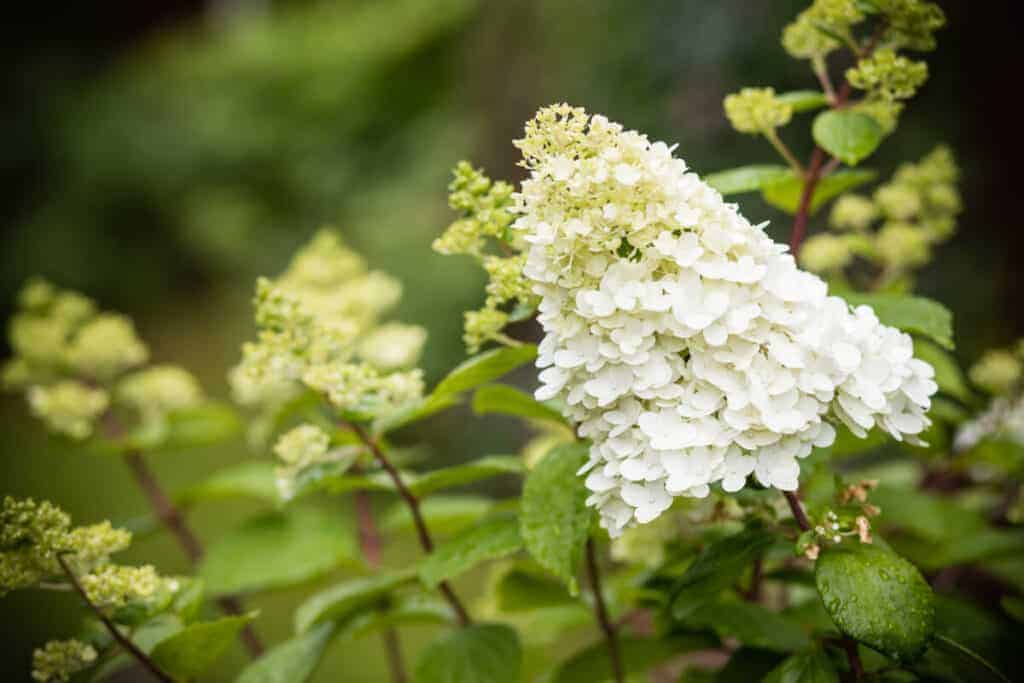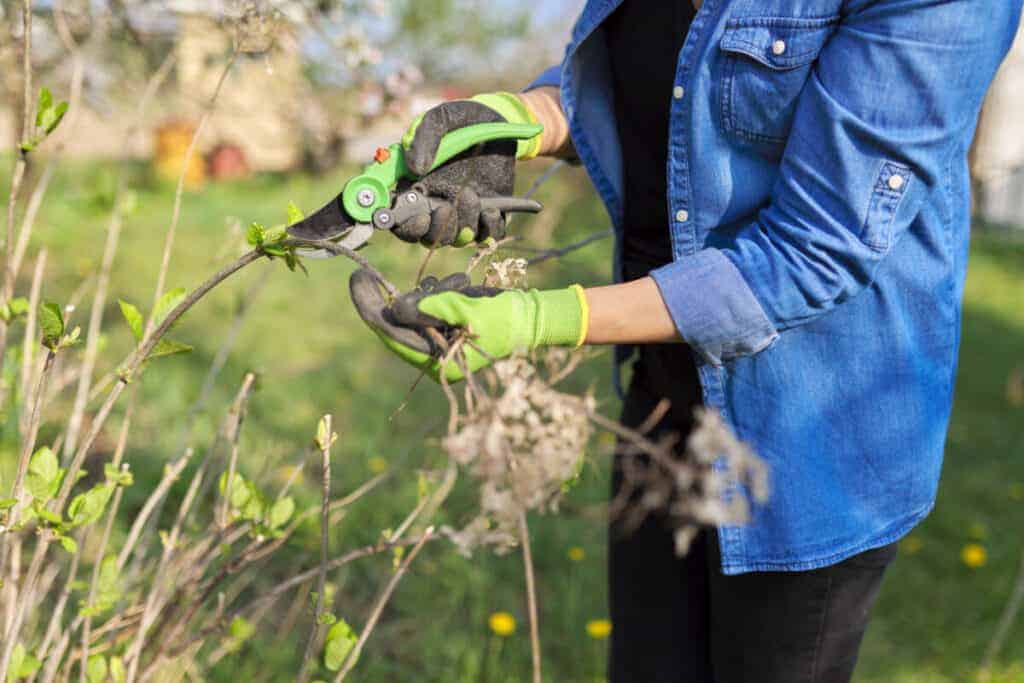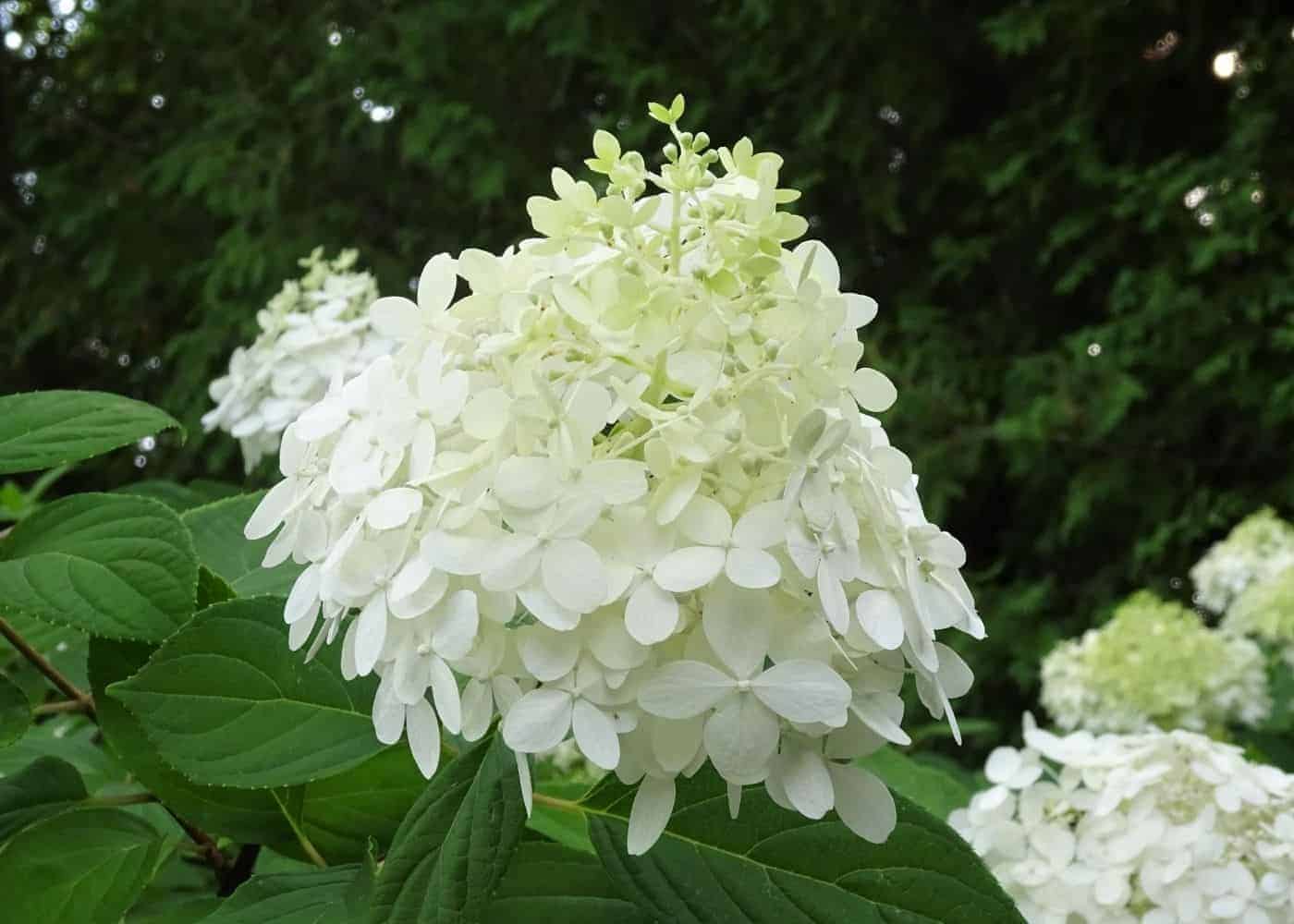Limelight hydrangea is a cultivar of Hydrangea paniculata with green-white flowers that mature to a soft pink hue. This flowering shrub generally forms large bushes that typically measure 6-8 feet tall and wide, but standard tree-form Limelight plants are also available. This cold-hardy variety can be grown in Zones 3-9, making it a great choice for the back of a border garden or a flowering hedge.
Limelight hydrangea basics
Limelight hydrangea (Hydrangea paniculata ‘Zwijnenburg’) is a popular variety of panicle hydrangea known for its pale green flowers that mature to a blush pink color. This is a larger variety of hydrangea, with shrubs reaching 6- 8 feet tall and wide when mature. Limelight hydrangeas can also be trained into hydrangea trees when young.
Limelight hydrangeas flower on new wood, meaning that they grow their flower buds in the early summer on stems that grew just a few months earlier during the spring. The flower panicles are conical clusters of small individual flowers. The blooms tend to be a pale lime green when they first open before fading to a creamy white. In late summer, the flowers start to turn a pink blush shade, becoming a darker dusky pink in the crisp fall weather before fading to brown after frost.
Limelight hydrangeas are one of the easiest types of hydrangeas to grow. They are very cold, hardy, and also drought-tolerant once the roots are well-established.
Limelight plants can be grown in full sun to partial shade. If the mature size of 6′-8′ tall is too large for your garden space, be sure to check out the dwarf version of Limelight, called Little Lime hydrangea, which grows to only 3′-5′ tall and wide.
“Limelight is a great accent plant and, because it flowers on the current season’s growth, it will continue to give a reliable display even if the stems have been damaged by frost.”
Hydrangeas: Beautiful Varieties for Home and Garden Hardcover, by Naomi Slade

Growing Limelight hydrangea
Limelight hydrangea is a great plant that lasts through multiple seasons. These hydrangeas are particularly resilient, lasting through early freezes as well as hot weather draughts. Limelights will typically tolerate frost from northern regions as well as the harsh heat in southern regions. Hydrangeas are also long-lived, allowing you to rely on these plants as the foundation for your landscape every year through the summer and fall.
Florists love Limelights just as much as gardeners. Cut blooms are long-lasting, just like the plant they come from. Providing a spectrum of color options, limelight blooms help create beautiful statements in floral arrangements. Cutting mature blooms in the cool morning will help them stay fresh looking for even longer. The blooms can even be dried if they are cut after turning green. Setting them upright to dry will allow you to use the Limelight blooms any time of year.
Planting Limelight hydrangea
The best time of year to plant a new hydrangea is early spring or fall. The more moderate climates of these seasons will help your plant to easily establish itself. While settled plants will tolerate frost and drought, a new plant needs a few months of ideal conditions before it is ready to take on the more harsh summer and winter seasons.
Choosing a spot for your new hydrangea will depend on the typical climate in your location. If you are in a hot or arid climate, the partial sun will be best; if you are in a cooler climate, the full sun will be ideal.
When choosing the planting location, consider the soil’s drainage. If your garden has a lot of dense dirt or clay, you should loosen or amend the soil before planting to allow for proper root growth. If the roots become soggy, the leaves will yellow and fall off early, and flower growth will be stunted.
After determining a planting spot for your Limelight, you will need to dig a hole the appropriate size for the root ball. The hole should be about the same depth as the root ball, allowing the plant to sit just at the level of the surrounding soil. The hole should be about twice as wide as the current roots.
If you are planting in a pot rather than directly in the ground, follow the same sizing guidelines when choosing pot size. Limelights grown in a pot will not grow to be as large, but this can be a great way to control location and size. You can grow the Limelight as a bush or as a small tree in a large pot.
After placing the Limelight hydrangea plant in the hole, fill the cavity halfway with soil before completely filling the hole with water. Wait for all the water to drain away before filling in the rest of the space with soil and watering the new soil until damp.
If you are planting multiple Limelight hydrangeas at the same time, plant each root ball 7 to 8 feet apart. This will give each plant plenty of space to grow unimpeded but is also close enough to create a uniform look when the plants grow to maturity. If you are planting for a hedge, 6 feet apart is perfect for balancing plant health and hedge density.
To protect against frost, add a few inches of organic mulch on the surface of the soil to help insulate the plant. To protect against overly hot weather, water more often than normal and make sure there is an appropriate amount of shade.

Sunlight requirements for Limelight hydrangea
Limelight Hydrangeas prefer partial or full sun for ideal flowering, depending on the climate. The partial sun will generally be plenty in warmer places (zones 7 through 9a). Having about four hours of direct sunlight in the morning and shade during the rest of the day will give your plant plenty of light while protecting it from the harsher afternoon heat.
A Limelight hydrangea should get full sun if you are in zones 3 through 6, where it is typically cooler. This means about six hours in zones 5 and 6 and definitely eight full hours of direct sun in zones 3 and 4. Your limelight will still live even if you are not hitting these sunlight recommendations, but following this guide will help you get the biggest and healthiest blooms.
The length of time that a plant is in sunlight directly influences the length of time the plant puts into creating flower stems. Both the temperature and the photoreception communicate to the plant the size of flowers it will sustain throughout the growing and blooming process. Striking the right balance of light relative to the environmental temperature will yield bigger and longer-lasting flowers.
Watering Limelight hydrangea
If you have cared for other species of hydrangeas before, you are probably used to watering the plants a lot. While most species require high levels of watering, Limelight Hydrangea can easily deal with droughts and are very sensitive to overwatering. It would be better to err on the side of underwatering rather than overwatering so your plant does not get root rot.
Watering for Limelight Hydrangeas is typically labeled as “average.” Watering every 7 to 10 days for most zones will keep your plant healthy and happy. In addition to the climate, the soil quality and drainage also affect how often you will need to water. The best way to ensure you are watering your Limelight appropriately is to check the soil regularly (especially when the plant is new).
To check the water level of your Limelight Hydrangea’s soil, simply dig a small hole or stick your finger into the surrounding soil, at least two inches deep. If all the soil you touched is dry, your plant is ready to be watered. If any of the soil in those two inches was still moist, hold off on watering until it dries out.
When you do water, water the soil thoroughly. Watering thoroughly means fully saturating all the soil in the pot or all of the soil under the radius of the plant. Make sure all of the soil gets damp past the surface. You can check this by returning to the planting location after watering and digging a small hole to see how far the water has seeped down into the soil.
Overwatering is a big concern, especially if they are potted or in poorly drained clay soil. If overwatered, the roots may develop root rot that makes the roots turn dark and mushy rather than light and firm. If your Limelight Hydrangea has root rot, you will likely see fewer flower clusters, or the clusters will be less dense. The flowers will have a permanently wilted appearance. The leaves may be overgrown in comparison to the flowers and will have a yellowed color rather than the classic deep green.
Fertilizing Limelight hydrangea
Fertilizing should be done early each spring before your shrub shows any significant new growth. Simply apply the fertilizer according to the package instructions, making sure you are covering a large enough area that the whole root structure will be able to benefit.
Limelight Hydrangeas are generally fed in the early spring and sometimes in mid-summer. Different fertilizer products have different guidelines for how much and how often to apply the fertilizer to the soil around the plant.
As with most plants, you must be careful about how much and how often you fertilize your Limelight Hydrangeas. Too little fertilizer combined with naturally poor soil means your plants will develop paleness in their leaves and poor, slow growth.
Be sure to read the instructions on the specific fertilizer you choose, as application amounts and frequencies vary between brands. Read more about hydrangea fertilizers.

Pruning Limelight hydrangea
Any damaged, diseased, or dead branches on a Limelight Hydrangea should be removed as soon as you notice them, but general pruning should take place in late winter or early spring each year. Pruning early will help avoid accidentally cutting any new growth or new buds.
Limelight Hydrangeas grow new stems each year and will only grow buds on the new wood. Trimming your plant back by about a third will help to encourage new growth while still leaving the support system intact. Although the old stems won’t flower, they will help shape your bush and support large blooms on the new stems.
Taking off enough of the old branches will help channel all the plant’s energy into creating new blooms rather than maintaining old growth. You can even prune by up to half if you are creating a specific shape.
Limelight hydrangea trees
If you want a Limelight hydrangea tree instead of a bush, take this time to prune the young Limelight into a tree shape. Select 1 to 3 of the plant’s strongest stems in the ground and remove the rest of them by clipping at ground level. Select about six main branches coming off this new single “trunk” stem to keep for the canopy, and cut off the rest. Make sure you are also cutting off any undergrowth to reveal the trunk of your tree. Trim the six branches you are keeping above the third or fourth bud to allow room for new branches to grow in the spring.
You will be left with a very thin skeletal form of a tree, but remember that you can be really aggressive during the pruning process and still enjoy a beautiful set of blooms in the summer and fall. New branches will grow during the spring to fill out your tree shape. Very young hydrangea trees may require staking for the first year or two as the trunk becomes stronger.
To maintain your tree, watch out for new shoots growing out of the ground around the base of the tree. Make sure to remove these new growths in addition to upkeep on the trunk of the tree.







